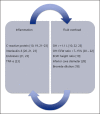Fluid Overload and Inflammation Axis
- PMID: 29478061
- PMCID: PMC6492921
- DOI: 10.1159/000485153
Fluid Overload and Inflammation Axis
Abstract
Extracellular fluid overload (FO), which is assessed using bioimpedance technologies, is an important predictor of outcome in dialysis patients and in patients with early stages of chronic kidney disease. While traditional cardiovascular abnormalities are assumed to mediate this risk, recently also, the importance of noncardiovascular factors, such as systemic inflammation and malnutrition has been shown. While both FO and inflammation are independent risk factors for mortality, recent studies have shown that their combined presence can lead to a cumulative risk profile. From a pathophysiologic viewpoint, FO and inflammation can also be mutually reinforcing. Inflammation could contribute to FO by hypoalbuminemia, capillary leakage, and a (unnoticed) decline in lean and/or fat tissue mass resulting in incorrect estimation of dry weight. Reciprocally, FO could lead to inflammation by the translocation of endotoxins through a congested bowel wall or by a proinflammatory effect of tissue sodium. The relative importance of these putative factors is, however, not clear yet and epidemiological studies have shown no clear temporal direction regarding the relationship between FO and inflammation. FO and inflammation appear to be part of (dynamic) clusters of risk factors, including malnutrition and hyponatremia. Technology-guided fluid management of the often vulnerable dialysis patient with FO and inflammation cannot yet be based on evidence from randomized controlled trials, in which these specific patients were in general not included. In the absence of those trials, treatment should be based on identifying actionable causes of inflammation and on the judicious removal of excess volume based on frequent clinical reassessment.
Keywords: Extracellular fluid; Inflammation; Malnutrition; Outcomes; Pathophysiology; Segmental bioimpedance.
© 2018 S. Karger AG, Basel.
Figures



References
-
- Yilmaz A, Yilmaz B, Kucukseymen S, Ozpelit E, Pekel N. Association of overhydration and cardiac dysfunction in patients have chronic kidney disease but not yet dialysis. Nephrol Ther. 2016;12:94–97. - PubMed
Publication types
MeSH terms
LinkOut - more resources
Full Text Sources
Other Literature Sources
Medical

